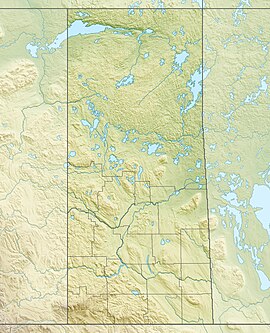| Great Sand Hills | |
|---|---|
 The Great Sand Hills | |
| Highest point | |
| Elevation | 727 m (2,385 ft)[1] |
| Prominence | 20 m (66 ft)[2] |
| Coordinates | 50°41′54″N 109°17′15″W / 50.6984°N 109.2876°W |
| Dimensions | |
| Area | 1,900 km2 (730 sq mi) |
| Geography | |
| Location | Saskatchewan, Canada |
| Rural municipalities | RM of Clinworth No. 230 |
| Geology | |
| Formed by | Glaciation |
| Rock age | 12,000 |
| Mountain type | Sand dune |
The Great Sand Hills,[3] also spelt Great Sandhills, are sand dunes in the south-west region of the Canadian province of Saskatchewan. The Great Sand Hills are the second largest active dunes in Saskatchewan, after Athabasca Sand Dunes, and are part of Great Sandhills Ecological Reserve,[4] which covers an area of about 1,900 km2 (730 sq mi). The sands that make up the dunes are made up of very finely ground sand called rock flour that were deposited near the end of the last ice age. The region around the sand hills is often windy and, as a result, the wind blows the fine sands around creating an ever-changing landscape.[5]
Swift Current, the fifth largest city in Saskatchewan, is 159 kilometres (99 mi) to the south-east while Leader, the closest town, is 38 kilometres (24 mi) to the north-west. Access is from Sceptre, which is 10 kilometres (6.2 mi) north of the hills. Sceptre is home to the Great Sandhills Museum & Interpretive Centre.[6]
- ^ "Maps showing Great Sand Hills, Saskatchewan". Canmaps. Yellow Maps. Retrieved 5 August 2022.
- ^ "The Great Sandhills". Great Sandhills Museum. Great Sandhills Museum. Retrieved 5 August 2022.
- ^ "Great Sand Hills". Canadian Geographical Names Database. Government of Canada. Retrieved 5 August 2022.
- ^ "Unique Places to visit in Saskatchewan". To Do Canada. 21 July 2023. Retrieved 26 March 2024.
- ^ "Great Sandhills". Tourism Swift Current. Tourism Swift Current. Archived from the original on 3 October 2022. Retrieved 5 August 2022.
- ^ "Welcome to the Great Sandhills Museum & Interpretive Centre". Great Sandhills Museum. Great Sandhills Museum. Retrieved 5 August 2022.

